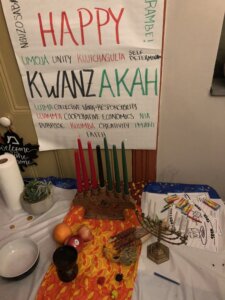At the Alexandria Black History Museum Kwanzaa candles display the traditional colors of black, red and green. Photo by Getty Images
With Hanukkah starting on Dec. 25, it couldn’t be easier to concelebrate with Kwanzaa this year.
If you can find black Hanukkah candles.
The African diaspora holiday named for the Swahili phrase for “First Fruits,” Kwanzaa runs annually from Dec. 26 to Jan. 1. That means the holidays coincide exactly this year, with Kwanzaa tucked neatly between Hanukkah’s first evening and last day.
Created in 1966 by Black activist turned professor Maulana Karenga, Kwanzaa celebrates pan-African culture and unity, though with no specific requirement that you have to be Black to participate. Noting that the holiday is non-religious and observed by Black people of any faith, including Judaism, Karenga writes that the holiday can be simultaneously universal and culturally particular to people of African descent.
That of course includes Black Jews, as well as their multicultural families and friends — though doing so usually means lighting a lot of candles: eight for Hanukkah, usually followed a few days or weeks later by seven more for the Kwanzaa candelabra, or kinara.
This year, though, offers a convenience, if not enhanced fire safety. The simultaneous holidays mean those celebrating both can light one candle each day (as opposed to the evening) and hit the right number for each holiday.
Except for one shopping glitch: While Kwanzaa candles are easily available, most are the size of tall table candles, with the diameter of a Shabbat candle; way too large to fit in a standard-sized hanukkiah. And they’re specified in three colors: three red (symbolizing struggle), three green (hope) and one black (African unity). While Hanukkah candles may come in any color, a fairly exhaustive online search comes up short for those in black.
Rite Lite Judaica of Brooklyn offers something close: a striking two-tone black and white candle (think black and white cookie).
“They alternate. Some are black on top, some are white,” said Rite Lite’s Larry Naftali, adding there’s no religious significance to them. “That’s for contrast.”
If you don’t mind re-lighting them halfway, you could break them apart and piece two halves together.
Told that Michael’s sells black birthday candles, he said: “We have birthday candle sized menorahs” — evoking a fond memory of my first menorah from my preschool days.
He also suggested a more high-tech solution, asking, “Do they make electric kinaras?”
An enterprising electrical engineer could have a field day with that idea. But you don’t have to be a licensed electrician to rig a celebratory device.

Shoshana Brown of the Black Jewish Liberation Collective has been celebrating Kwanzakkah, a single observance of both holidays, for two decades. The group is hosting this year’s hybrid observance on Dec. 26.
When she started, she too found a dearth of black Hanukkah candles, but took matters into her own hands.
“When I got into my Kohenet journey, l learned about candle making,” she said. “So I made black Hanukkah candles. You can order beeswax sheets and wicks.”
She later shared her innovations with other collective members nationwide. “I sent them a whole package that also included wooden dreidels that I painted red, black and green.”
There are still technicalities, such as with the fact that a hanukkiah is actually nine branches. If you’re color-coding them, Brown posited, “What color is the shamash?”
And in a strict Halachic sense, Brown said, a kinara wouldn’t quite be interchangeable with a menorah — even just for seven days — because with “a kosher menorah, the candles all have to be at the same level except the shamash,” and most kinaras a pyramid-shaped.
In reality, most Jews who celebrate Hanukkah have more than one hanukkiah (call it a plethora of menorah). Adding a kinara to the mix can only make the season more festive. And then there are purists like me with oil menorahs that may be truer to the holiday’s origins — though with mine, the shamash still takes a candle. The oil lasts much longer than candles, which after decades has me still secretly hoping it’ll go on for eight days.
If nothing else, this year’s coincidence does invite a joint observance. And though both holidays celebrate hope and the perseverance of a people, Brown points out they shouldn’t be trivialized as marking the exact same thing. Kwanzaa, she said, is also “about movement, building, and culture creation.”
And as a creative candle maker, she would know.

I hope you appreciated this article. Before you go, I’d like to ask you to please support the Forward’s award-winning, nonprofit journalism during this critical time.
We’ve set a goal to raise $260,000 by December 31. That’s an ambitious goal, but one that will give us the resources we need to invest in the high quality news, opinion, analysis and cultural coverage that isn’t available anywhere else.
If you feel inspired to make an impact, now is the time to give something back. Join us as a member at your most generous level.
— Rachel Fishman Feddersen, Publisher and CEO


